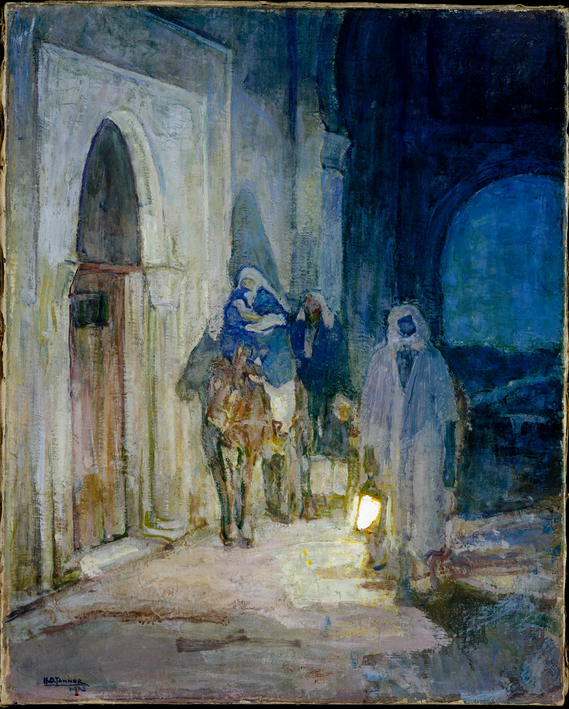Henry Ossawa Tanner (American, 1859-1937), Flight Into Egypt, oil on canvas, 1923, Collection of the Metropolitan Museum of Art
Henry Ossawa Tanner (American, 1859-1937) was one of the most celebrated artists of his generation. His paintings are often emotive and evocative and regularly draw on biblical and spiritual themes to underscore moral lessons. They also regularly employ aesthetic qualities unique to the French-inflected American Art of the late nineteenth and early twentieth centuries, a period when artists in the United States increasingly drew inspiration from their European counterparts. Tanner’s depiction of the Holy Family’s Flight Into Egypt, painted in 1923, is a hallmark of his production. At the current moment in our national history and especially during this holiday season, Tanner’s image takes on a new resonance and a new poignancy.
In the painting, Christ’s mother Mary rides into a gated city while holding the swaddled Jesus. Her husband Joseph follows closely behind. Ahead of their small party a faceless and ghostlike figure carries a lantern which illuminates the scene - the proverbial light in the darkness. The image is executed in a palette which is distinct to the Tonalist-tinted work the artist created throughout his career. Tanner, like many of his contemporaries, was influenced by the French, from Barizon landscapists to Realist painters.
Born in the United States, Henry Ossawa Tanner was one of seven children born to Sarah Tanner, a mixed race woman who had escaped slavery via the Underground Railroad. He studied art under the great Thomas Eakins at the Pennsylvania Academy and moved to Paris in 1891 to study at the acclaimed Académie Julian. Largely due to the racism he experienced in the United States, and also to the cultural opportunities afforded to artists living in Europe, Tanner made France his home for the remainder of his life. He was eventually recognized for his artistic excellence with the nation’s highest honor, being made a Chevalier in the Légion d'honneur.
Tanner also traveled extensively in the Middle East and drew inspiration for his paintings, including Flight Into Egypt from the topography, the architecture, and the people he saw there. His immersive exploration gave way to studied attempts at capturing an authentic view of a cohesive biblical landscape to match the reality Tanner found on the ground in places like Jerusalem. His paintings are marked by this quest for truth and also influenced deeply by his own sincere religious faith.
Tanner was the son of Benjamin Tucker Tanner, a bishop in the African Methodist Episcopal Church. Living abroad on Christmas in 1896, he wrote home saying "I have made up my mind to serve Him [God] more faithfully.” He went on to dedicate the majority of his career to painting touching religious scenes, including this plaintive image executed nearly thirty years after Tanner’s letter to his parents. It is a painting born out of devout sincerity.
The artist’s spirituality is evident in much of his later work, but to me, Tanner’s subtle treatment of many of these images is what makes his oeuvre so striking. Unlike other artists of the mid and late eighteenth century, Tanner largely avoided the negative impulses of the popular Orientalist movement in his scenes of the real places in which biblical stories are set. His paintings are paintings first and foremost - not illustrations meant to aggrandize Western audiences. Nor are they burdened by the saccharine sentimentality which is evident in other images of similar subjects made during this period. Tanner’s dual influences from his uniquely American Christian upbringing and his immersion in avant-garde European movements shaped his art and his psyche.
In Flight Into Egypt we witness not a laboriously produced illustrative image of a scene from scripture, but a painterly treatment of an emotive human story. The subdued palette and quality of the surface of the painting result in a romantic image, which provokes empathy and understanding. The power of this piece is evident because it succeeds at making us feel something nearly a century after it was painted. It allows us to see the humanity of saintly figures and in turn, the people they represent in Tanner’s time and our own.
As the small party marches slowly past the closed doors of a walled hamlet at night, we also find ourselves attuned to a feeling of alienation, which would come to define many paintings made by Tanner and his peers, particularly those in America. There is a lonesomeness to journey of the Holy Family, one mirrored in the religious experience of many. In this case that lonesomeness and solitude is portrayed by a painter who after his death was classified by his own son as a mystic.
This painting is deeply, resonantly, profoundly beautiful because it transcends what we expect from such a work. It is also a reflection of Tanner’s own transcendent experience which culminated in his success in France. The story of a refugee family would have been incredibly important for the son of a freed slave, just as it should be important to contemporary viewers watching the American border crisis unfold.
Henry Ossawa Tanner was a painter of remarkable skill, who harnessed his own experience and his religious views to create paintings of breathtaking and unusual sensitivity. His Flight Into Egypt is a singular expression of many of the best qualities of his oeuvre and still has lessons to teach to viewers today.




